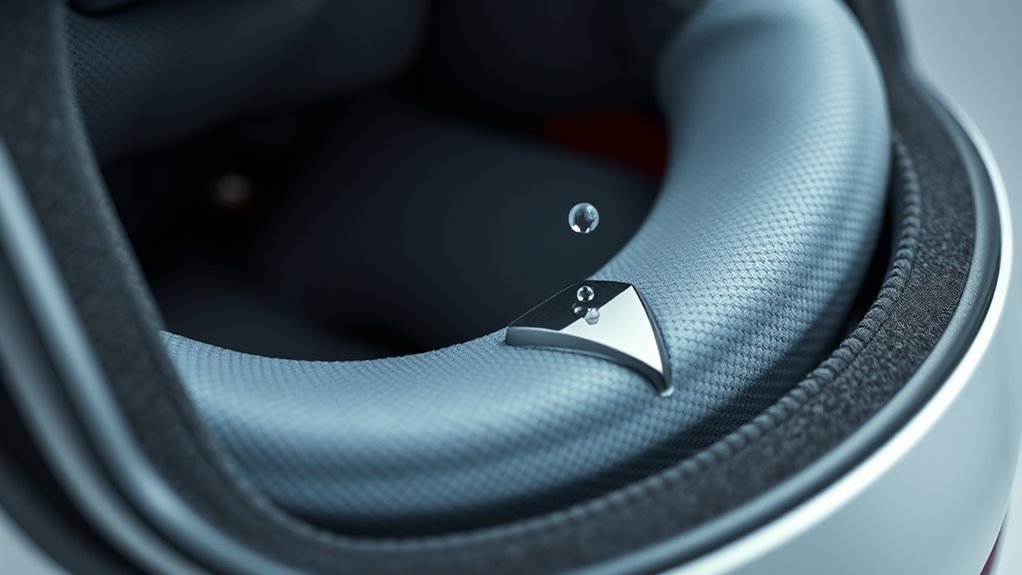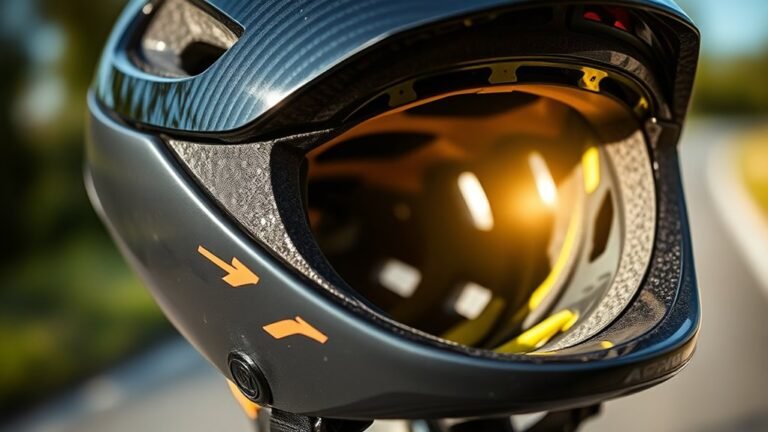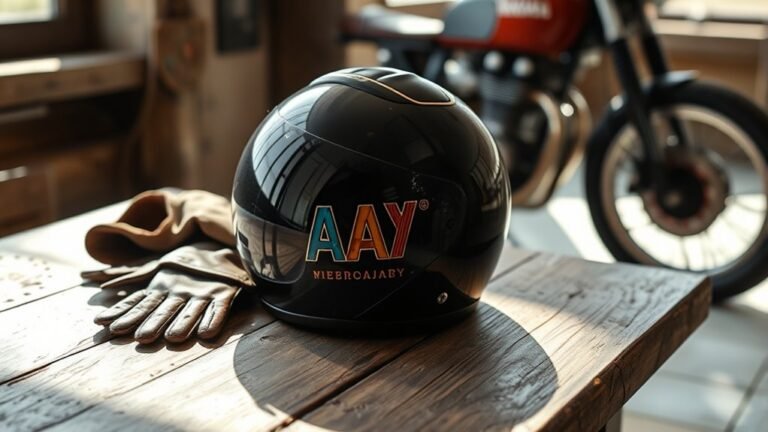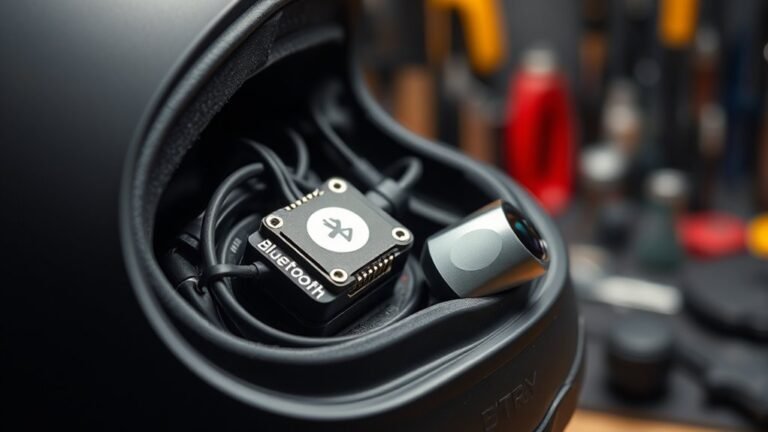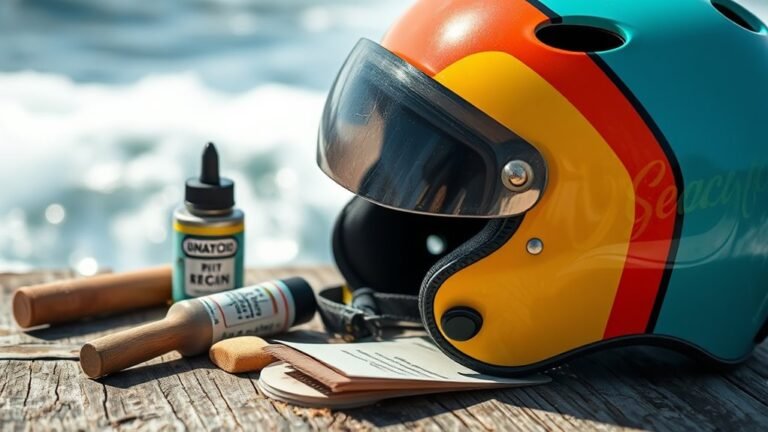Water-Resistant Padding Materials in Helmets
Water-resistant padding materials in helmets are essential for enhancing both safety and comfort. These materials, like neoprene foam and waterproof polyester, prevent moisture penetration while offering effective shock absorption. They also promote breathability and manage sweat, ensuring a comfortable fit. Plus, with features like antimicrobial treatments, they help maintain hygiene during use. Understanding these innovations can greatly impact your choice of helmet, leading to a safer and more enjoyable experience in various conditions.
The Importance of Helmet Safety
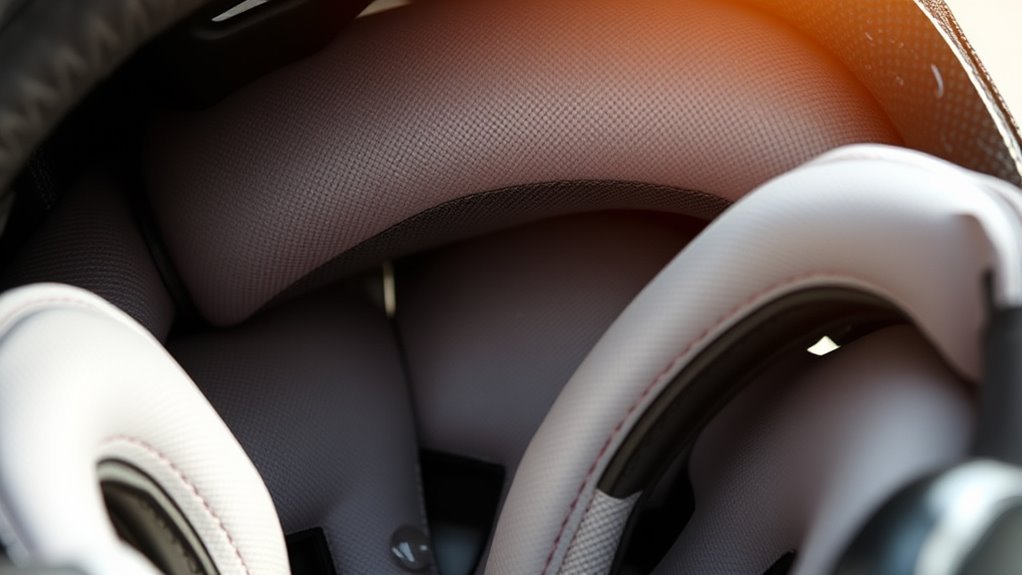
While you may think helmets are just a precaution, their importance in preventing serious injuries cannot be overstated. Helmet regulations are designed to guarantee that every helmet meets specific safety standards, which directly correlate to reduced risk of head trauma during impacts. By adhering to these standards, manufacturers create products that effectively absorb shock and disperse energy. This is vital for maintaining your freedom to ride, skate, or cycle without the constant fear of injury. The right helmet can be the difference between a minor incident and a life-altering event. As a result, it’s essential to choose helmets that comply with established safety standards, as they provide the necessary protection to keep you safe while enjoying your activities. Safety isn’t just a rule; it’s a necessity.
Understanding Helmet Padding Materials
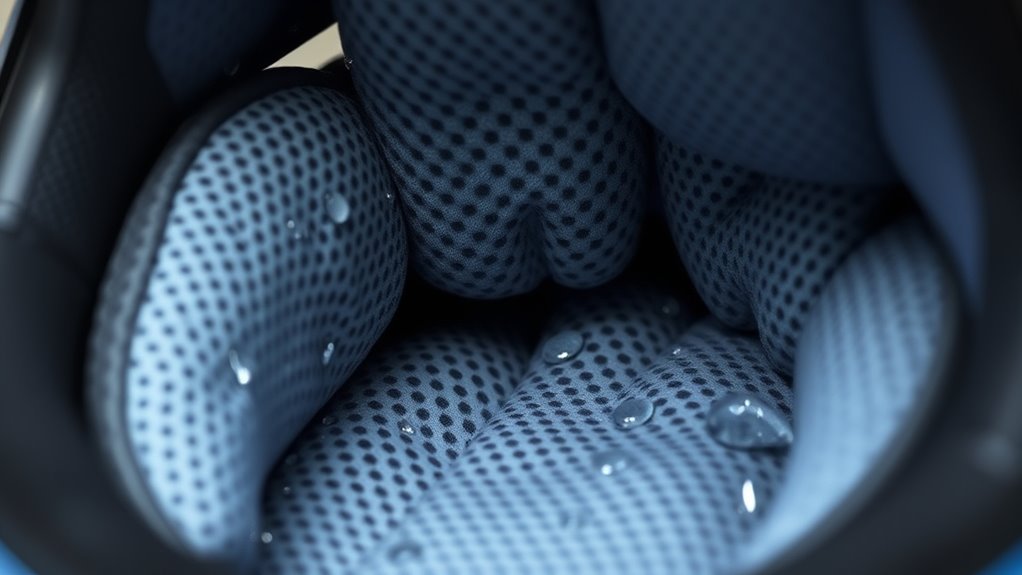
Understanding the role of padding materials in helmets is essential for maximizing safety and comfort. The right padding can greatly affect your riding experience, balancing protection with wearability. Key aspects to take into account include:
- Padding durability: Guarantees longevity and consistent performance over time.
- Moisture absorption: Aids in maintaining comfort by managing sweat during use.
- Impact resistance: Enhances protection by dispersing forces during an impact.
- Weight: Lightweight materials improve comfort without sacrificing safety.
- Breathability: Allows air circulation, preventing overheating during extended wear.
What Is Water-Resistant Padding?
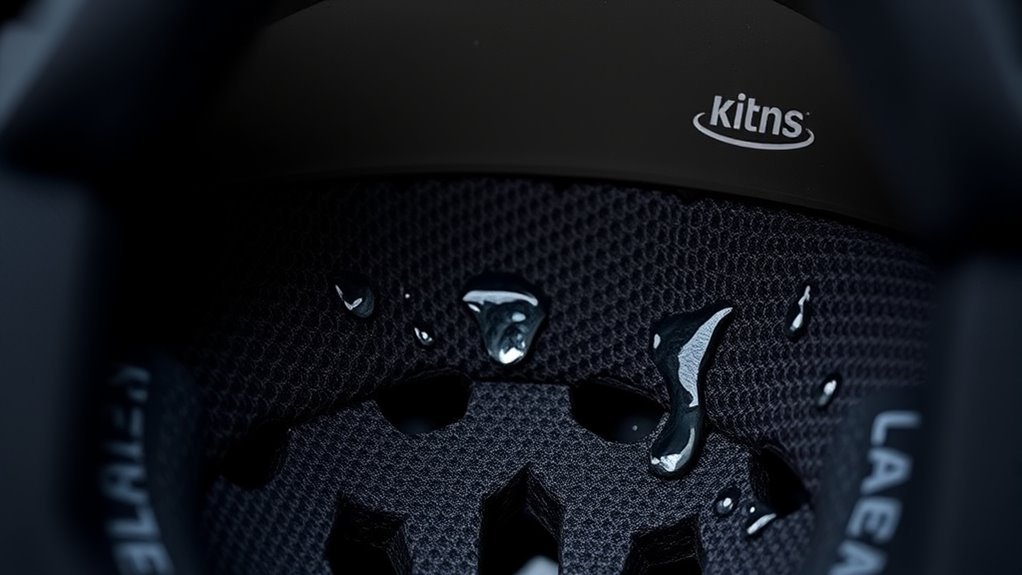
Water-resistant padding is designed to enhance helmet performance in wet conditions, ensuring that moisture doesn’t compromise comfort or safety. This padding utilizes waterproof technology to repel water, maintaining padding effectiveness even during heavy rain or splashes. By integrating advanced materials, manufacturers create a reliable barrier against moisture, allowing you the freedom to explore your passions without concern for your gear.
| Feature | Benefit | Emotional Impact |
|---|---|---|
| Waterproof Technology | Keeps you dry | Peace of mind |
| Comfort | Enhances fit | Confidence in safety |
| Durability | Long-lasting use | Freedom to adventure |
With water-resistant padding, you’re equipped to tackle any environment while keeping your focus on the journey ahead.
Advantages of Water-Resistant Padding
As you navigate diverse environments, the advantages of water-resistant padding become increasingly evident. These features greatly enhance your experience, ensuring safety and comfort. Here are the key water resistance benefits you can expect:
Navigating diverse environments reveals the undeniable benefits of water-resistant padding for safety and comfort.
- Improved Durability: Resists wear from moisture exposure, extending the lifespan of your helmet.
- Enhanced Moisture Control: Keeps sweat and rain at bay, maintaining a comfortable environment inside the helmet.
- Reduced Weight: Lighter materials contribute to overall comfort during extended wear.
- Increased Hygiene: Minimizes mold and bacteria growth, promoting a healthier user experience.
- Versatile Performance: Suitable for various activities, ensuring you’re protected in any condition.
With these advantages, water-resistant padding not only enhances performance but also empowers you to tackle challenges confidently.
How Water-Resistant Padding Works
To understand how water-resistant padding works, you need to examine the material composition and the moisture management techniques employed. These elements are essential in preventing water penetration while maintaining comfort and breathability. By analyzing these factors, you can appreciate the effectiveness of modern helmet padding in wet conditions.
Material Composition Analysis
While the primary function of helmet padding is to provide comfort and protection, the integration of water-resistant materials greatly enhances performance in adverse conditions. Understanding the material composition is essential for optimizing padding durability and minimizing moisture absorption.
Key components include:
- Closed-cell foam: Prevents water penetration while offering cushioning.
- Hydrophobic fabrics: Repel moisture, keeping padding dry.
- Polyurethane coatings: Enhance durability and water resistance.
- Ventilation channels: Allow airflow, reducing moisture buildup.
- Antimicrobial treatments: Prevent odor and degradation from trapped moisture.
Moisture Management Techniques
Effective moisture management techniques are integral to the functionality of water-resistant padding in helmets. These methods focus on optimizing moisture absorption and enhancing sweat evaporation. Advanced materials often incorporate hydrophobic fibers that repel water while allowing moisture vapor to escape, keeping your head dry and comfortable. This dual action prevents sweat buildup, which can lead to discomfort and reduced performance. Additionally, some padding systems use specialized coatings that facilitate rapid moisture transfer away from the skin, promoting quicker evaporation. By understanding these techniques, you can appreciate how water-resistant helmets maintain a balance between protection and comfort, ensuring that even in intense conditions, you stay focused and free to perform at your best without the distraction of excess moisture.
Different Types of Water-Resistant Materials
When selecting water-resistant padding materials for helmets, neoprene foam and waterproof polyester are prominent options. Neoprene foam offers excellent flexibility and durability, while waterproof polyester provides a lightweight and cost-effective alternative. Understanding the specific advantages of these materials will enhance your decision-making process for peak helmet performance.
Neoprene Foam Advantages
Although various water-resistant materials exist, neoprene foam stands out due to its unique combination of durability, flexibility, and insulation properties. When you choose neoprene, you’re opting for a material that performs exceptionally well under various conditions. Its advantages include:
- High resistance to water: Keeps your helmet dry in wet conditions.
- Excellent shock absorption: Protects your head during impacts.
- Versatile applications: Suitable for various helmet styles.
- Thermal insulation: Maintains comfort in diverse temperatures.
- Long-lasting performance: Retains shape and quality over time.
These characteristics make neoprene a top choice for helmet padding, ensuring both your safety and comfort while you enjoy your freedom in any environment. Embrace the benefits of neoprene durability and flexibility for ultimate protection.
Waterproof Polyester Options
Waterproof polyester is a notable alternative in the domain of water-resistant materials, offering distinct advantages for helmet padding. Its waterproof properties guarantee that moisture doesn’t compromise the performance of the padding, while its polyester durability assures longevity and resilience under various conditions. Below, you’ll find a comparison of various waterproof polyester options:
| Type | Waterproof Properties | Polyester Durability |
|---|---|---|
| Coated Polyester | High | Excellent |
| PU Laminated Polyester | Moderate | Good |
| TPU Polyester | High | Very Good |
| Nylon-Polyester Blend | Moderate | Good |
| Breathable Polyester | Variable | Fair |
These options provide the freedom to choose the right material that meets your specific needs, guaranteeing both comfort and protection in unpredictable environments.
Impact on Comfort and Fit
While the primary function of helmets is to provide protection, the integration of water-resistant padding materials considerably enhances both comfort and fit. These materials allow for effective comfort adjustments and fit customization, ensuring a tailored experience for each user.
- Improved moisture management prevents discomfort during extended use.
- Enhanced breathability reduces heat buildup, fostering a cooler environment.
- Lightweight design minimizes bulk, promoting a more natural fit.
- Contoured shapes adapt to individual head profiles, enhancing security.
- Durable construction withstands wear, maintaining fit over time.
Ultimately, selecting helmets with water-resistant padding not only serves safety but also prioritizes user comfort, allowing you the freedom to focus on your activity without distraction.
Maintenance and Care for Water-Resistant Helmets
Regular maintenance is essential for ensuring the longevity and performance of water-resistant helmets. To keep your helmet in optimal condition, employ effective cleaning techniques such as using mild soap and water, avoiding harsh detergents that can degrade materials. Gently scrub the padding and shell, ensuring you reach all nooks and crannies. After cleaning, it’s vital to utilize appropriate drying methods; air drying in a well-ventilated area is preferred to prevent moisture buildup. Avoid direct sunlight or heat sources which can warp the materials. Regularly check for wear and tear, as timely repairs can extend your helmet’s life. By following these steps, you maintain not just the helmet’s functionality but also your safety and comfort during use.
Innovations in Helmet Design
As helmet technology evolves, manufacturers are integrating advanced materials and designs to enhance safety and comfort. Innovations like smart helmet technology and modular helmet designs are revolutionizing user experience. These advancements not only improve protection but also cater to individual preferences.
Helmet technology is advancing rapidly, merging safety and comfort through smart features and customizable designs for an enhanced user experience.
- Smart connectivity for navigation and communication
- Modular designs for customizable fit and accessories
- Lightweight materials reducing fatigue during use
- Enhanced ventilation systems for better airflow
- Integrated safety features like impact sensors
Choosing the Right Helmet With Water-Resistant Features
How do you guarantee that your helmet provides ideal protection in wet conditions? Start by considering key helmet selection tips, such as examining the water-resistant features and padding materials. Look for helmets with hydrophobic liners that repel moisture, guaranteeing comfort and safety during use. Conduct a features comparison among different brands to identify those that excel in water resistance without compromising impact protection. Pay attention to ventilation systems designed to minimize water accumulation, and guarantee the exterior shell is coated with a waterproof finish. Remember, a well-chosen helmet balances functionality and your freedom of movement, enhancing your overall experience in challenging environments. Ultimately, investing in a water-resistant helmet can elevate your confidence in adverse weather conditions.
Frequently Asked Questions
Can I Wash Water-Resistant Helmet Padding in a Washing Machine?
No, you shouldn’t wash water-resistant helmet padding in a washing machine. The agitation and heat can damage the materials, compromising their protective qualities. Instead, use gentle washing techniques, like hand washing with mild soap and lukewarm water. This approach guarantees proper padding maintenance while preserving its water-resistant properties. Always check the manufacturer’s guidelines for specific care instructions, as they can vary based on the padding’s material and construction.
How Long Does Water-Resistant Padding Last Before Needing Replacement?
Water-resistant padding typically lasts between three to five years, depending on usage and care. You’ll notice replacement indicators like visible wear, reduced comfort, or diminished water resistance. The padding’s lifespan can be influenced by exposure to sweat, moisture, and impact. Regular inspections will help you maintain peak performance, ensuring safety and comfort during your rides. Prioritize replacement when you see these signs, allowing you to embrace your freedom on the road without worry.
Are There Any Allergies Associated With Water-Resistant Padding Materials?
Yes, there can be allergies associated with water-resistant padding materials. Individuals may experience padding allergies or material sensitivities due to the chemicals used in manufacturing these materials, such as latex or certain synthetic compounds. It’s essential to identify any known sensitivities before using products containing these pads. If you’re prone to allergies, consider checking the material composition and consult with a healthcare professional to guarantee safety and comfort during use.
Can Water-Resistant Padding Be Added to Existing Helmets?
Yes, you can add water-resistant padding to existing helmets. Picture your helmet, sleek and protective, getting an upgrade that enhances its functionality. This padding installation involves careful helmet modifications, ensuring a snug fit to maintain safety standards. You’ll want to choose high-quality materials that won’t compromise comfort. Ultimately, this addition can provide you with freedom from moisture concerns during your rides, keeping you focused and confident in your protective gear.
Do Water-Resistant Helmets Cost More Than Standard Helmets?
Yes, water-resistant helmets typically cost more than standard helmets. When you look at price comparisons, you’ll find that the advanced materials and technology used in water-resistant designs contribute to the higher price point. Analyzing market trends reveals that as demand for enhanced protective gear increases, manufacturers are investing in better waterproof capabilities, which further drives up costs. Ultimately, you’re paying for added protection and durability, which can enhance your freedom during activities.
